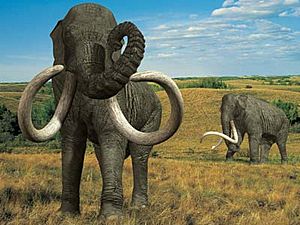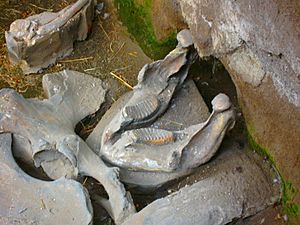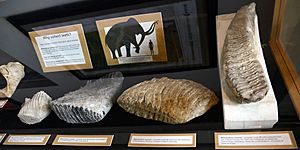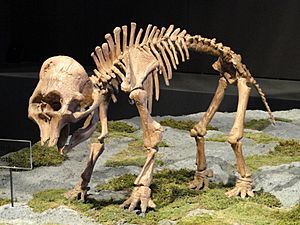Columbian mammoth facts for kids
Quick facts for kids Columbian mammothTemporal range: late Pleistocene
|
|
|---|---|
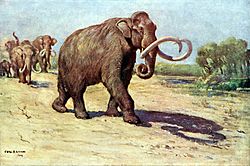 |
|
| Columbian mammoth | |
| Scientific classification | |
| Kingdom: | |
| Class: | |
| Order: | |
| Family: | |
| Genus: | |
| Binomial name | |
| Mammuthus columbi (Blumenbach, 1799)
|
|
The Columbian mammoth (Mammuthus columbi) was a giant elephant-like animal. It lived in North America, from what is now the United States all the way south to Costa Rica. These huge creatures roamed the Earth during the Pleistocene epoch, which was a long time ago.
Columbian mammoths were among the last types of mammoths to exist. They evolved from the steppe mammoth, which came to North America about 1.5 million years ago. Today, their closest living relative is the Asian elephant. Smaller mammoths, called pygmy mammoths, lived on the Channel Islands and actually evolved from Columbian mammoths.
These mammoths were truly enormous! They could stand 4 meters (13 feet) tall at the shoulder and weigh up to 10 tonnes (20,000 pounds). That's like 130 adult humans! They had long, curved tusks and four large molars (grinding teeth). These molars were replaced six times during a mammoth's life. Just like modern elephants, they probably used their tusks and trunks to pick up things, fight, and find food.
Scientists have found bones, hair, and even what was in their stomachs. However, no complete, well-preserved bodies have been found. Columbian mammoths liked open areas, like parklands, where they ate sedge, grass, and other plants. They didn't live in the cold Arctic parts of Canada. That area was home to their cousins, the woolly mammoths.
It's possible that Columbian and woolly mammoths lived in some of the same areas. Genetic studies even suggest they might have had babies together. Many sites have been found with several Columbian mammoth skeletons. These might be from single events, like a sudden flood, or from animals getting trapped over time.
Columbian mammoths lived at the same time as early humans in North America, called Palaeoamericans. These ancient people hunted mammoths for food and used their bones to make tools. They also drew pictures of mammoths in their art. Mammoth remains have been found near tools from the Clovis culture. This means humans either hunted them or found their bodies to use. The Columbian mammoth disappeared about 11,000 years ago. This was likely due to climate change changing their homes, hunting by humans, or a mix of both.
Contents
How did mammoths evolve?
The very first relatives of elephants, called Proboscidea, appeared about 55 million years ago. The closest living relatives of elephants today are dugongs and manatees (sea cows) and hyraxes (small, furry mammals).
The elephant family, Elephantidae, started about six million years ago in Africa. This family includes both living elephants and mammoths. The mastodon (Mammut) was a distant relative of mammoths, but not a direct ancestor. The Asian elephant (Elephas maximus) is the closest living relative to mammoths.
What did Columbian mammoths look like?
The Columbian mammoth was huge! It stood about 4 meters (13 feet) tall at the shoulder. It weighed up to 10 tonnes (20,000 pounds). This made it bigger than today's African elephants and even bigger than the woolly mammoth. Male mammoths were usually larger and stronger than females.
Like other mammoths, the Columbian mammoth had a high, rounded head. Its back sloped downwards, with a high hump at its shoulders. Young mammoths, though, had backs that curved outwards, like Asian elephants.
What about their tusks and teeth?
Columbian mammoths had very long tusks. These tusks were more curved than those of modern elephants. The longest mammoth tusk ever found belonged to a Columbian mammoth and was 4.9 meters (16 feet) long! Other tusks were usually between 3.5 and 4.1 meters (11.5 to 13.5 feet) long. Female mammoths had much smaller and thinner tusks.
About a quarter of the tusk's length was hidden inside the mammoth's skull. Columbian mammoth tusks were generally less twisted than those of woolly mammoths. Baby mammoths grew small "milk tusks" a few centimeters long when they were about six months old. These were replaced by permanent tusks about a year later. Tusks kept growing throughout the mammoth's life, but they grew slower as the animal got older. They grew about 2.5 to 15 centimeters (1 to 6 inches) each year.
Mammoths also had powerful molars (grinding teeth). They chewed their food by moving their lower jaw forward to close their mouth, then backward while opening. This motion made the sharp ridges on their teeth grind the food. These ridges were very strong, helping the mammoth chew large amounts of food, even if it had grit in it.
How did mammoths get trapped?
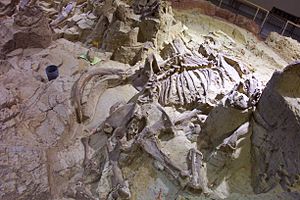
Many mammoth skeletons have been found in "natural traps." These include sinkholes and tar pits. The Hot Springs Mammoth Site in South Dakota, USA, is a great example. It's a sinkhole about 40 meters (130 feet) long that was active for 300 to 700 years before it filled with dirt.
Scientists believe this sinkhole is between 140,000 and 190,000 years old. So far, 58 Columbian mammoths and 3 woolly mammoths have been found there, and all of them were males!
It's thought that, like modern male elephants, male mammoths often lived alone. They might have been more "adventurous," especially young adults, which made them more likely to get into dangerous situations than the more careful females. Mammoths might have been drawn to the sinkhole by warm water or tasty plants around its edges. Then, they would slip in and die from drowning or starvation. You can even see deep footprints where mammoths tried to free themselves from the mud!
What did they eat?
An adult Columbian mammoth needed a lot of food, more than 180 kilograms (400 pounds) every day! They probably spent up to twenty hours a day looking for food.
Their trunks were very useful for eating. They could pull off large clumps of grass, pick buds and flowers, and tear off leaves and branches from trees and bushes. Their tusks also helped them find food, like digging up plants or stripping bark from trees. What they ate depended on where they lived.
How long did they live?
Modern elephants are pregnant for 21–22 months, and mammoths probably were too. The lifespan of mammals is often related to their size. Since modern elephants can live up to 60 years, woolly mammoths, which were similar in size, likely lived that long too. Because Columbian mammoths were even bigger, they might have lived up to 80 years!
We can guess a mammoth's age by looking at the growth rings inside its tusks. Each major line represents a year of growth. You can even see weekly and daily lines! Dark bands show summer growth, so scientists can tell what season a mammoth died in.
Tusk growth would slow down when it was hard to find food, like during an illness, or if a male mammoth was forced to leave its herd. Like other elephants, mammoths kept growing even after they became adults. Their bones show that males grew until they were about 40 years old, and females until they were 25.
Mammoths had six sets of molars throughout their lives. The first set wore out by 18 months old. The third set lasted for about ten years. The final, sixth set of molars appeared when the mammoth was about 30 years old. Once this last set of teeth wore out, the mammoth couldn't chew its food anymore and would eventually die of starvation.
Why did they disappear?
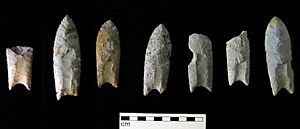
Both Columbian and woolly mammoths disappeared at the end of the Pleistocene epoch, around 11,000 years ago. Many other large animals, known as Pleistocene megafauna, also vanished around this time. Scientists aren't sure if these extinctions happened quickly or slowly. During this period, 40 different mammal species disappeared from North America, almost all of them weighing over 40 kilograms (90 pounds). So, the mammoths' extinction wasn't an isolated event.
Scientists have two main ideas about why mammoths died out: climate change or hunting by humans, or a combination of both.
The climate change idea suggests that warmer weather caused the mammoths' habitat to shrink. Their open parklands turned into forests, grasslands, or semi-deserts, with less variety of plants for them to eat.
The "overkill hypothesis" blames human hunting for the extinction. However, a 2002 study suggested that there wasn't enough archaeological evidence to fully support this idea.
No matter the exact reason, large animals are generally more at risk of extinction than smaller ones. This is because they have smaller populations and don't reproduce as quickly.
Images for kids
-
1863 lithograph of a partial molar from Georgia.
-
Smilodon (saber-toothed cat) and dire wolves fighting over a Columbian mammoth body in the La Brea Tar Pits, painted in 1911.
-
Drawings of petroglyphs from Utah, showing two Columbian mammoths. A bison drawing is on top of one of the mammoths.
See also
 In Spanish: Mamut colombino para niños
In Spanish: Mamut colombino para niños



